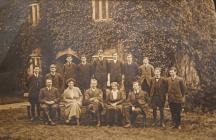Content can be downloaded for non-commercial purposes, such as for personal use or in educational resources.
For commercial purposes please contact the copyright holder directly.
Read more about the The Creative Archive Licence.
Description
An integral part to any excavation is the processing of finds. Once finds have been recovered from an excavated context, it is taken to be processed. The material in each tray is quickly assessed to see which finds need to be washed. Washing of finds essentially is the removal of dirt and soil that are attached to the find, by removing this material it is then possible to look more closely at each find to identify what the object is (Barker 1982). The washing of finds can be a delicate process depending on the type of material and how well it has survived, for instance a fragment of pottery that is heavily degraded and crumbling might not be washed as the process may further damage the find (Hurcombe 2014). Other material such as metal work, particularly iron, is also not washed as this will further corrode and damage the object, instead metalwork is usually kept separate and then dry brushed to remove as much dirt as possible (Shopland 2005). During an archaeological excavation all manner of artefacts can be discovered from the tiniest fragment of flint to extremely large objects, like the worked stone in the image above, all of which needs to be washed and catalogued.
Once the finds have been washed and cleaned, the next stage is to “bag and tag” the finds, a process in which all of the material is sorted into types such as pottery, bone, stone, etc. This process is usually conducted on sight and material may briefly be looked at and identified, although at a later stage each piece will be examined more closely (Westman 1994). Once the finds have been sorted into their typology they are bagged in see through plastic bags, and information such as the trench number and excavation year (particularly handy if a site is being excavated over subsequent years), context number which the find came from and if it is an deemed to be of significance a small find number may be given to the find (Westman 1994). Once the finds are off site, they will be examined more carefully by specialists who will provide their opinions of the type of material and more crucially which period they are likely to date from. This can be useful for dating contexts ad if all the material date to a specific period then it is likely that the context in question dates to that period of time (Barker 1982). Usually on excavations there will be a member of the excavation team who is the Finds Manager, who’s responsibility it is to process all finds both on and off site, liaise with specialists and who will usually publish the finds report summarising all of the material that has been found during the excavation. For the Middleton Hall Excavation Marie Woods was the finds manager, she can be seen above cleaning a large piece of worked stone that once was the top of a colonnade which adorned the Paxton mansion that was built within the estate during the 1790’s.
Barker, P. 1982 Techniques of Archaeological Excavation. London. Batsford
Hurcombe, L. 2014 Archaeological Artefacts as Material Culture. Routledge.
Shopland, N. 2005 Archaeological Finds: A Guide to Identification. University of Michigan. Tempus Publishing
Westman, A. [Ed] 1994 Archaeological Site Manual. London: Museum of London Archaeological Service, III Edition.






Do you have information to add to this item? Please leave a comment
Comments (0)
You must be logged in to leave a comment